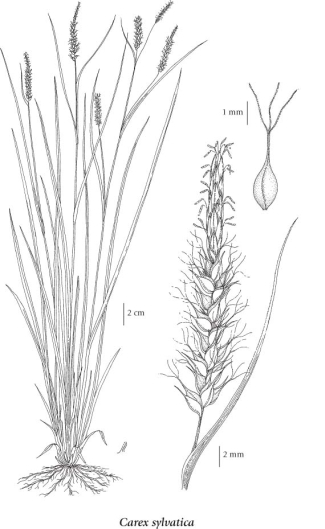Carex sylvatica Huds.
European woodland sedge
Cyperaceae (Sedge family)
Introduction to Vascular Plants
European woodland sedge
Cyperaceae (Sedge family)
Introduction to Vascular Plants
Species Information
General:
Perennial, tufted herb from short, stout rhizomes; stems 30-90 cm tall, erect or decumbent, longer than the leaves.
Leaves:
Sheaths long, concave to blunt; ligules longer than wide; blades 3 to 5 per stem, flat, scattered on the stem, 2.5-4 mm wide.
Flowers:
Spikes 1 to 7, the terminal spike linear, 1-2 cm long, usually with male flowers only, the lower 2 to 4 spikes narrowly cylindrical, 2-5 cm long, with female flowers, remote, long-stalked, nodding; bracts subtending the female spikes short-sheathing, leaflike, 1.5-10 cm long, the lowermost longer than the subtended spikes.
Fruits:
Perigynia egg-shaped, 5-6 mm long, 1.5-2 mm wide, greenish to straw-coloured, smooth, shiny, 2-ribbed near the margins, short-stalked, the beaks slender, as long as or longer than the bodies, deeply bidentate; female scales lanceolate to narrowly egg-shaped, narrower than the perigynia, the centres green and 3-nerved, the tips pointed to more usually strongly awned; stigmas 3; achenes 3-angled, 1.8-2.5 mm long.
Illustration

If more than one illustration is available for a species (e.g., separate illustrations were provided for two subspecies) then links to the separate images will be provided below. Note that individual subspecies or varietal illustrations are not always available.
Illustration Source: The Illustrated Flora of British Columbia